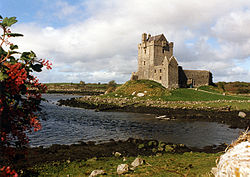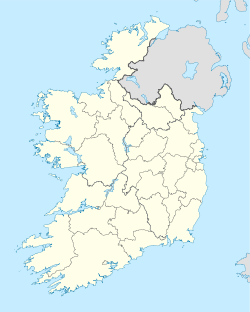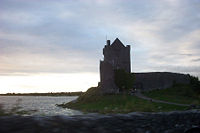- Kinvara
-
This article is about the village in south County Galway. For the townland in west County Galway, see Kinvara (Moycullen).
Kinvara
Cinn Mhara— Village — Dunguaire Castle Location in Ireland Coordinates: 53°08′20″N 8°56′17″W / 53.139°N 8.938°WCoordinates: 53°08′20″N 8°56′17″W / 53.139°N 8.938°W Country Ireland Province Connacht County County Galway Elevation 10 m (33 ft) Population (2006)[1] – Village 1,160 – Urban 563 – Environs 597 Dialing code 091 Irish Grid Reference M369103 Kinvara (Irish: Cinn Mhara, meaning "head of the sea") is a sea port village located in the south of County Galway in the province of Connacht on the west coast of Ireland. Kinvara is also the name of the parish in which the village is situated. Kinvara is occasionally spelled Kinvarra in English; this may be seen on some maps and road signs, although Kinvara is the most common spelling used nowadays. Kinvarra is still the official form of the name for the townland as shown on OSI maps[2] and this form is still used on polling cards as the name of the townland while the District Electoral Division (DED) is called Kinvara.
Kinvara's area population according to the 2006 Census was 1160. The Great Famine in the 1840s and a series of emigrations that continued up until the 1960s reduced the population of the village – once a thriving port and a significant exporter of corn and seaweed – to no more than a few hundred people. From around the 1980s the population of the parish of Kinvara started to increase while the village started to grow in size.
Contents
Geography
The village lies at the head of Kinvara Bay known in Irish as Cinn Mhara (or more recently Cuan Chinn Mhara) from which the village took its name. This is an inlet in the south-eastern corner of Galway Bay. Kinvara is situated in the territory of Ui Fiachrach Aidhne also known as Aidhne,[citation needed] which is coextensive with the diocese of Kilmacduagh (Cill Mhic Dhuach). Kinvara is situated in the west of the former barony of Kiltartan (also in County Galway) and close to the border with County Clare in the province of Munster, near the Burren.
History
The modern parish of Kinvara is roughly with coextensive[citation needed] with the slightly larger late medieval territory of the Ó hEidhin clan Coill Ua bhFhiachrach ("forest of the descendents of Fiachrach") which was an ancient sub-district of Aidhne stretching from Garryland to Doorus.[citation needed] The Ó hEidhin / (O Hynes) clan who were also chiefs of Ui Fiachrach Aidhne. The modern parish of Kinvara contains the civil parishes of Kinvarradoorus and Killinny or the medieval parishes of Kinvara, Doorus and Killinny(Killina). Kinvara developed around an Ó hEidhin (O Hynes) towerhouse (now completely demolished) close to the main pier and the medieval church of St.Comam or St.Caimín (now in ruins) which is situated between the main road through the village and Céibh a'Chéile (the oldest part of the quay). The church of St. Caimín dates to the early 13th century but is built on the site of Saint Caimín's original early medieval church.[citation needed] It belongs to the style of architecture known as the School of the West which was a style of building in use in Connacht before the English invasion of the kingdom in the early 13th century.[citation needed]
Dunguaire Castle
Main article: Dunguaire CastleDunguaire Castle (Irish Dún Guaire [lit, the Castle of Guaire]), one of the principal towerhouses of the Ó hEidhin (O Hynes) clan, is located to the east of the village. According to the great 19th century Gaelic scholar John O'Donovan, the castle was built by Éamonn Ó hEidhin or Eoghann Mantach Ó hEidhin in the early 16th century[citation needed]. Lewis's Topographical dictionary (1831) states that a certain Rory More Dearg O Shaughnessy was the builder but this is probably an explanation from local folklore and not based on any fact as the O Shaughnessy's (kinsmen of the Ó hEidhin clan) territory of Kinelea lay five miles southeast of Kinvara.[citation needed] It was occupied by Fiacha Ó hEidhin towards the end of the 16th century. This towerhouse is believed to have been built on or close to the site of Dúrlas Guaire the main residence of Guaire Aidne mac Colmáin,[citation needed] the 7th-century king of Uí Fhiachrach Aidhne and Connacht. The rath (earthen enclosure) on the small peninsula east of Dún Guaire is thought to be the remains of Dúrlas Guaire also called Ráth Dúrlais.[citation needed]
Dunguaire Castle was used as a filming location for the Scottish castle home of the main character in the 1979 film North Sea Hijack.
A view of Kinvara from Dunguaire Castle.
Terry Alts
The Terry Alt agrarian resistance movement of the early 19th century was active in the Kinvara area. In 1831, a large force of Terry Alts gathered on the border between Kinvara parish and Oughtmama parish, Burren, County Clare and challenged the English Crown forces to battle. They, however, dispersed before the arrival of the English forces. They also unsuccessfully attempted to ambush a body of English infantry at Corranroe in the west of the parish, which led to the death of one of their members.
War of Independence
The first shots of the 1916 Easter Rising in County Galway were fired in Kinvara.[citation needed] The incident took place outside the curate's house on the Green Road when the RIC attempted to arrest him and local members of Óglaigh na hÉireann.[citation needed]
Festivals
Kinvara is home every year to two festivals, Fleadh na gCuach ("the cuckoo festival") an Irish music festival at the start of May and the Cruinniú na mBád ("gathering of the boats") in mid August. Anthony Moylan is credited as the person who came up with the idea for the Fleadh on the new bank holiday weekend to commemorate the festival of Bealtaine, around which time the cuckoo is first heard. The Cruinniú na mBád, also largely the idea of Anthony Moylan, is the larger and longer-running, it celebrates the traditional sailing craft (Galway Hookers) and the trade they once did between Kinvara, western County Galway and the north of County Clare. Turf was imported into Kinvara from the west of County Galway while barley, lime, and timber was exported from Kinvara. Turf, the main fuel used here prior to coal and oil, had to be imported as Kinvara is in an area without bogs. The festival started in 1979 and features a series of boat races as well as a variety of other events on the pier. The Fleadh na gCuach (started in 1994) is a festival of Irish music that celebrates the old Irish festival of Bealtaine (the First of May), which in Ireland marks the start of Summer.
Annalistic references
- 814.Ailbhe of Ceann Mhara, died.
See also
- List of towns and villages in Ireland
- Island Eddy
References
- ^ "Census 2006 – Volume 1 – Population Classified by Area" (PDF). Central Statistics Office Census 2006 Reports. Central Statistics Office Ireland. April 2007. http://www.cso.ie/census/documents/census2006_volume_1_pop_classified_by_area.pdf. Retrieved 2011-06-19. total is of the Kinvara electoral area
- ^ Kinvarra, 1:50,000, Ordnance Survey of Ireland
Places in County Galway Towns Villages - Ahascragh
- Ardrahan
- Aughrim
- Ballinderreen
- Ballyconneely
- Ballymacward
- Ballymoe
- Ballynahinch
- Barna
- Barnaderg
- Bealadangan
- Bullaun
- Camus
- Carnmore
- Casla
- Castleblakeney
- Castlegar
- Clarinbridge
- Cleggan
- Clonbur
- Coalpits
- Corofin
- Corrandulla
- Corr na Móna
- Craughwell
- Cregmore
- Eyrecourt
- Furbo
- Garrafrauns
- Inverin
- Kilcolgan
- Kilconnell
- Kilkerrin
- Kilkieran
- Killimor
- Kilronan
- Kinvara
- Laurencetown
- Leenaun
- Letterfrack
- Lettermore
- Maam Cross
- Maum
- Menlough
- Milltown
- Monivea
- Moylough
- Newbridge
- New Inn
- Recess
- Rosmuck
- Rossaveal
- Roundstone
- Skehana
- Spiddal
- Turloughmore
- Williamstown
- Woodford
Townlands - Attymon
- Baile na hAbhann
- Derrymullan
- Hollygrove
- Kilclooney
- Killagoola
- Kinvara (Moycullen)
- Lios an Gharráin
- Meelick
- Muckanaghederdauhaulia
- Oldthort
- Tulrush
Baronies - List of townlands in County Galway
- Category:Mountains and hills of County Galway
- Category:Rivers of County Galway
- Category:Geography of County Galway
Categories:- Untranslated Irish place names
- Towns and villages in County Galway
Wikimedia Foundation. 2010.






